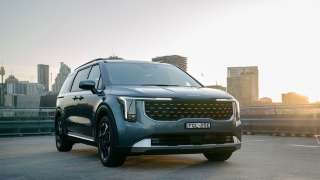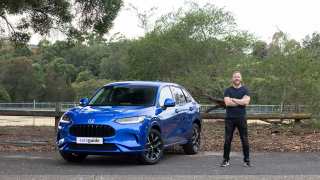
Can-Am Spyder oddball with some good vibes
“It's not just a car! It's not just a bike! It's a little bit of both things with wheels that you like! When you take one wheel off a car or add one wheel to a bike; you get the Can-Am Spyder. It's a trike!”
Hmm. I've missed my calling.
But the Spyder is not a standard-form trike with two rear wheels and one in front. Following the basic format of pre-war Morgans, it's a two-fronted tail-wheeler; best to land power to earth via a single rear orb while steering with a wide wheelbase set of dual mag-hubbed front tyres. And it works very well.
But let's begin with a little bit of background ...
The Spyder is generated by the company that first devised the snowmobile, and is possibly easiest understood as a kind of snowmobile for the road. The proportions are similar and the position of the rider/driver essentially interchangeable.
That company is now known as BRP (Bombardier Recreational Products), and an unconventional and sparky enterprise it is.
For BRP, already with substantial market share for vehicles bound for snow (snowmobiles), dirt (quad bikes) and water (Sea-Doos), the Spyder represents a first serious bid for street sales.
It's a risky, mega-millions move, but company CEO Jose Boisjoli is comfortable with risk.
As a child growing up on a Quebec farm he took to riding speedy snowcraft, and now in his 50s maintains a fondness for rapid personal transport.
Boisjoli's an unlikely looking petrolhead. Bespectacled and slight, you'd pick him as the company accountant long before you'd pick him as a user of BRP's machines, let alone this enterprise's main driver.
Then he begins talking about the Spyder's development.
“The first prototype used a two-stroke engine,” he says. “Solidly mounted. Very fast.”
He rolls his eyes at the memory. “So fast!”
Then came tamer — only slightly tamer — roadworthy versions.
“They were all fun, but they weren't completely safe for public use,” Boisjoli says.
How so?
“Our test riders would be on two wheels when they hit highway exits.”
His eyes positively sparkle.
“And entries.”
Those two-wheeling days are long gone, years back.
During test rides at the Spyder's Austrian launch last month, even the most desperate trike try-hards struggled to push their machines into an imbalanced or awkward stance.
The Spyder's natural grip is impressively high, and over even that the complex Bosch traction and balance electronics work hard to counter maniac moments. (There are many patents pending on the Spyder's various tilt-and-steer computerised controls; how many exactly, Boisjoli isn't saying.)
So, let's roll a Spyder out on some lightly infested Austrian roads.
The V-twin Rotax engine starts instantly via handlebar commands and settles quickly into a mild pulsing beat. Possibly too mild — the engine is heavily muffled and may not offer much sonic appeal to the Harley-Davidson retiree set (although its quietness may appeal to neighbours of the Harley-Davidson retiree set).
Select first gear through the foot-activated motorcycle gear lever — one down, four up — and you're away.
I hadn't ridden anything even resembling a motorcycle for 20 years before I took to the Spyder, but it's weird how muscle memories simply kick in.
The first time I needed to brake I reached for a lever in front of my right hand. It wasn't there, as it was on my Kawasaki in 1986.
All Spyder braking is done through a right-foot pedal.
Lucky that the three wheel discs bite quickly, or my brief hand-foot confusion may have led to an unanticipated Australian-Austrian interface moment.
Boisjoli is a fan of the Rotax engine's rompy sub-5000rpm antics, and it's hard to disagree with him. A certain amount of vibration adds character.
To quote the CEO and the Beach Boys, you can have “good vibrations”.
Above 5000rpm the Rotax begins to sing; it'll pull beyond 8000rpm, at which point upshifts become addictive fun.
Corners arrive quickly when behaving so.
Those with a motorcycle background (that is to say, almost all at the launch) adapted more rapidly to medium-high-speed Spyder handling than those more used to four wheels (that is to say, me), but Bosch stability electrics are always there to rescue the unwary.
I'll flatter myself and assume I was riding quickly enough for Herr Bosch to occasionally kick in.
He's an unobtrusive co-pilot.
The potential market for the Spyder in Australia is immense.
There's any number of former motorcyclists who crave open-air travel without risking contact with open-wound gravel. Also, the Spyder's snappy acceleration will sate those missing motorcycling's instant right-twist responsiveness.
This machine has some serious zest.
Against that — and here we must note again BRP's fondness for risk — the Spyder is a trike.
It's an oddball deal, like a Segway, although not nearly as pointless. Its makers believe the “what on Earth is that?” factor will encourage sales.
But it'll be a bold Sydneysider who owns the first Spyder in his/her street.
Then again, the first Valiant Charger owner was likely a bold sort, and those coupes sold like hell.
Helped by a famous jingle, of course; perhaps BRP could revive it, and have customers screaming: “Hey, Spyder!”
The Bottom Line
A quirky answer to a question few so far have thought to ask. Despite the quirks, the machine does have a practical side.
Snapshot
Can-Am Spyder
Price: $US14,990 (TBA in Australia).
Engine: Rotax 998cc, V-twin liquid cooled, with 79kW and 104nM.
Safety: ABS, traction control, stability control with roll-over mitigation, and a dynamic power steering system.





